The Pentium III chipsets market is in a funny
situation now - everybody knows that a DDR memory coupled with a
processor with a SDR bus doesn't provide a considerable performance
gain. On the other hand, the price difference between PC133 and
PC2100 may be smoothed out very soon. That is why chipsets for Pentium
III with DDR support are still developing. Well, why not?
ALi's new DDR chipset ALi
The Aladdin Pro 5T is not a new model, it is just the second
version of the Aladdin Pro 5. The "T" letter in its name stands
for support of Pentium III on the Tualatin core. And now this chipset
doesn't only exist on paper: there is at least one motherboard based
on it - ASUS TUA266.

I have already mentioned that the PC2100 DDR SDRAM together with the CPU
Intel Pentium III (or Celeron) will hardly increase the performance much
since the processor bus has a bandwidth twice narrower than the memory.
The chipset manufacturers are well aware of it and do not place production
of this chipsets into the first position. Taking these facts into consideration
I assume that today we have gathered all chipsets which will ever be released
for the Socket 370 platform.
DDR chipsets for Socket 370
| Chipset |
VIA Apollo Pro266 |
SiS 635 |
ALi Aladdin Pro 5T |
| North Bridge |
VT8633 |
SiS635 |
M1651T |
| South Bridge |
VT8233 |
M1535D+ |
| Bus connecting North and South Bridges |
V-Link, 266 MBps |
MuTIOL, 1200 MBps |
32 bit 33 MHz PCI, 133 MBps |
| FSB frequency, MHz |
66/100/133 |
66/100/133 |
66/100/133 |
| Memory frequency, MHz |
66/100/133 |
66/100/133 |
66/100/133 |
| Asynchronism |
SDRAM=FSB+-33* |
SDRAM=FSB+-33* |
SDRAM=FSB+-33* |
| SMP support |
+ |
n/a |
n/a |
| Memory types supported |
SDRAM, VCM SDRAM, DDR SDRAM |
SDRAM, DDR SDRAM |
SDRAM, DDR SDRAM |
| ECC memory support |
+ |
n/a |
n/a |
| RAm (max.), GB |
4 |
1.5 |
3 |
| AGP modes |
1X/2X/4X |
1X/2X/4X |
1X/2X/4X |
| AGP FastWrites |
+ |
+ |
+ |
| ISA support |
- |
- |
- |
| Ultra ATA |
33/66/100 |
33/66/100 |
33/66/100 |
| Integrated SuperIO |
+ |
- |
+ |
| System monitoring |
+ |
- |
- |
| USB ports |
6 |
6 |
6 |
| AC'97/MC'97 |
+ |
+ |
+ |
* The memory frequency cannot be lower than 66 MHz
and higher than 133 MHz.
The table shows that the ALi Aladdin Pro 5T is
an intermediate between the VIA Apollo Pro266 and SiS 635: on the
one hand, it supports a large RAM, on the other hand, it obviously
doesn't have a multiprocessor and ECC memory support. But as a matter
of fact, it has an older architecture than the SiS 635 - almost
every manufacturer has refused a PCI bus as a connecting link between
bridges. There are only ALi and AMD who still keep on doing it.
By the way, the HyperTransport bus developed by AMD is already licensed
by ALi, and exactly this bus will probably be used by ALi instead
of the PCI one.


As for differences between these chipsets, I think they are not critical.
And you will hardly face any problems caused by usage of one chipset instead
of another.
Testing technique and test system configuration
| CPU |
Intel Pentium III 1 GHz |
| Motherboard |
Soltek SL-65DRV |
ECS P6S5AT |
ASUS TUA266 |
| Chipset |
VIA Apollo Pro266 |
SiS 635 |
ALi Aladdin Pro 5T |
| Memory |
256 MBytes PC2100 |
256 MBytes PC133 |
256 MBytes PC2100 |
256 MBytes PC133 |
256 MBytes PC2100 |
| HDD |
Western Digital WD150BB (7200 rpm, 2 MBytes
cache) |
| Video card |
ASUS V8200 Deluxe (NVidia GeForce3, 64 MBytes
DDR SDRAM) |
| Operating system |
Windows 2000 Professional SP2, DirectX 8.0a |
The testing technique and a set of tests are the same as they
were for the VIA Apollo Pro266 and SiS 635 (see SiS
635 review).
You may object saying that at the time passed the boards could acquire
new BIOS versions, new drivers etc. That is why we conducted mini-tests
in Quake III, SPEC ViewPerf and Cachemem in order to find out whether the
new BIOS version affects the performance of the board tested earlier. Well,
in this case no changes were noticed, that is why we have taken old results
for three boards from the review mentioned above.
ASUS is known as a company that squeezes out a chipset to get the highest
performance possible. That is why the tests will demonstrate the performance
of exactly the chipset rather than of the board.
Test results
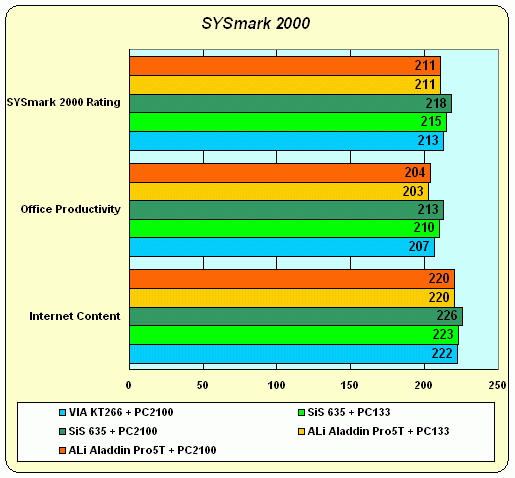
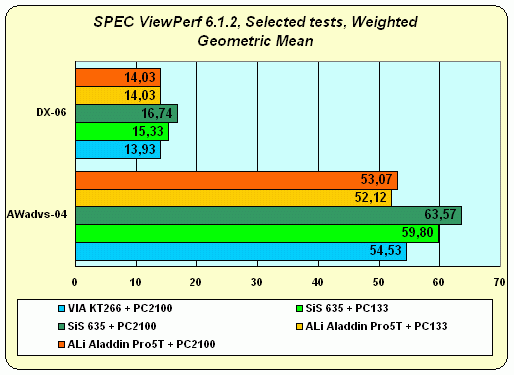
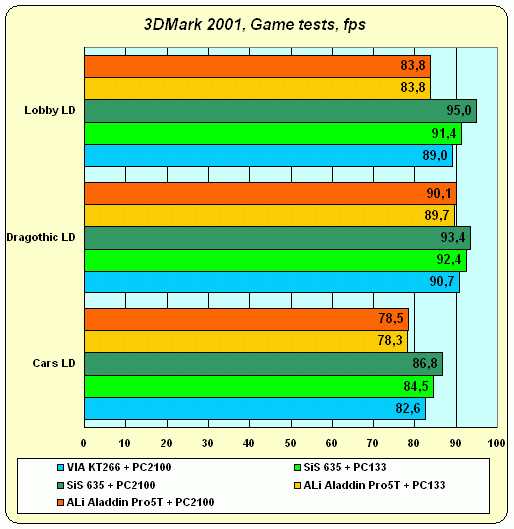
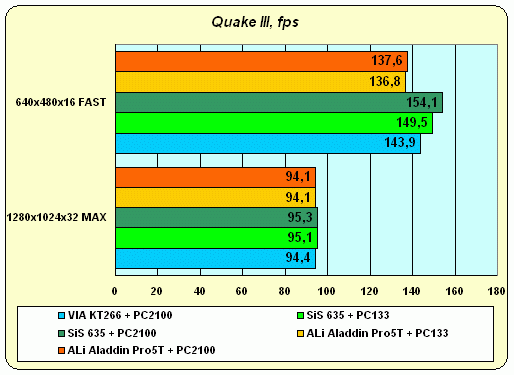
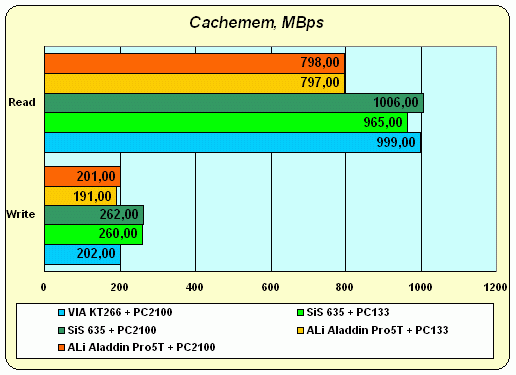
Well, the Ali's chipset loses in all tests, regardless of the memory type
used. The low-level test of the memory subsystem efficiency - Cachemem
- reveals the reasons. In the speed of reading the ALi's chipset yields
to the slowest competitor by 20%!
Conclusion
Well, ASUS didn't want to be out of the game and thus released a DDR chipset
for the Socket 370 platform, like 3 other manufacturers of chipsets for
x86 platforms. Traditionally, ASUS produces boards on the chipsets for
Acer Labs Inc., at least one for each chipset regardless of its popularity.
The product is not sensational, but its characteristics are rather good:
support of all SDRAM types (PC100, PC133, PC1600, PC2100) and new Pentium
III on Tualatin, UltraATA/100 and 6 USB ports. As for the board, there
is also nothing bad that we could say about it. There is even an AGP Pro
connector on it. The sound subsystem is, however, absent. But this has
already become a tradition for a certain range of products for the leading
Taiwanese board maker (for example, CUSL2-C (i815EP), CUV266 (VIA Pro266)).
The performance is not striking. But if we compare two ASUS boards which
have almost the same functions - ASUS TUA266 on the ALi Aladdin Pro 5T
and ASUS CUV266 on VIA Apollo Pro266, we will see that while the TUA266
costs $95, the CUV266 is available at $118. I suppose other board makers
have the same price ratio. What other attractive features does this chipset
have? Well, it's a Tualatin support.
This low-end chipset from ALi is intended for all low-end motherboards
supporting all modern standards and both SDRAM types. Its major competitor
is probably the SiS 635. From the performance viewpoint, the SiS 635 looks
more attractive, but here everything depends on a manufacturer. The ALi
Aladdin Pro 5T has already reserves a place in the line of ASUSTeK. Besides,
there is a definite group of users who are guided by exactly the name of
a manufacturer rather than by the speed and accessories of a board. A "full-sized
ATX board from ASUS with PC2100 DDR and PC133 support at $95" will be a
determining factor for them. And I can't say they are wrong.
P.S. The prices are given for the Eastern Europe.
Write a comment below. No registration needed!








